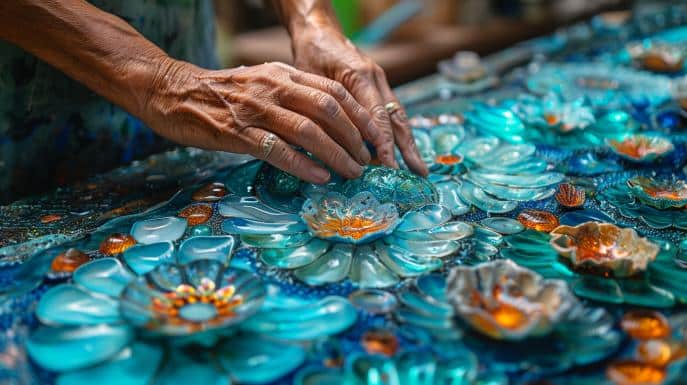Have you ever imagined transforming what would go to waste into unique pieces of art for your home? With “Creative Recycling: Tips for less waste”, this is not only possible, but also becomes a fascinating journey. Discover how recyclable materials can become decorative treasures, while you contribute to a more sustainable world. Get ready to explore amazing ideas that reduce waste and add a special touch to your home!
How can we transform recyclable materials into art for our home?
Art with recycled materials appears as a vibrant response to the need to reduce waste, and sustainable decoration takes on innovative contours that harmonize environmental care with personal expression. But how can we combine aesthetics and ecological responsibility in our own home?
Firstly, it is refreshing to seek inspiration that shows us how to transform common objects into decorative elements. This stage invites us to see beyond the obvious, to imagine new forms and functions. By taking glass jars, often discarded after use, we can start a transformation project: convert them into stylish lamps, for example. The step-by-step process involves cleaning the pots, painting them or adorning them with techniques such as decoupage, and installing electrical components for lighting.
Sophistication lies in the simple act of reimagining. PET bottles, often a symbol of pollution, have incredible artistic potential. Cutting, painting, assembling – each step leads us to new forms, from vases to sculptures. The versatility of the bottles allows us to create pieces that integrate with our home decor, reflecting our personality and environmental commitment.
Each recycled object tells us a story – about the circular economy, innovation and possibility. It's not just about decorating, but about contributing and transforming spaces in a sustainable and conscious way. As you look around, it's time to consider: what else can I reinvent in my home to foster an artistic life aligned with the well-being of the planet?
What DIY projects can I do to promote sustainability in my home?
In the context of a sustainable home, eco-friendly DIY projects explore the creative reuse of materials, resulting in less waste sent to landfills and incinerators. For example, PET bottles can be transformed into useful resources for gardening, such as creating a vertical garden, promoting the cultivation of vegetables even in confined spaces. Further instructions can be found at Elis's blog, which offers rich content on the subject.
In addition to gardening with recyclable items, another engaging idea is building with recycled pallets. Pallets, commonly discarded by supermarkets and warehouses, can be transformed into furniture or decorative objects. From a simple bookcase to elegant sofas and beds, pallets offer a rustic aesthetic and are surprisingly versatile.
Gardening techniques that make use of recyclable materials not only contribute to a greener environment, but also to environmental education. Imagine children learning about the life cycle of plants while watering a garden made from old plastic bottles – it's a practical and visually impactful experience.
The practices of creative recycling and upcycling, highlighted in the discussions and in the Elis's blog, reveal how mundane objects, considered trash, can have their life cycle extended and become something of new value. Never underestimate a 'useless' item – with a little creativity, it can serve a beautiful and useful role in your home. By embracing these practices we not only transform our homes, but we also cultivate a more conscious and responsible community environment.
This eco-friendly perspective encourages the reuse of resources, encouraging a sustainability mindset that goes beyond recycling. Instead of discarding, we reimagine. By doing this, we reduce the need to produce new materials and contribute to a cleaner, greener world, step by step.
How do I incorporate creative recycling into children's daily lives?
Let's embark on the upcycling journey and explore how to introduce this valuable practice into children's lives. When we think about upcycling for children aged 3 to 10, we can imagine many possibilities. But how to make recycled toys for this age group?
A simple way is to transform cardboard tubes into educational toys. At the tutorial, we found detailed steps to create new learning objects. It is possible, for example, to make binoculars for budding adventurers or confetti launchers for imaginary parties.
Equally important is involving children in upcycling projects with used clothes and fabrics. These projects are not only creative but also encourage autonomy and motor skills. An example might be customizing a painting apron from an old shirt.
And we also have recycling kits. Different from purchased toys, these kits challenge children to assemble and disassemble structures, learning about fittings and shapes. How to create a fun and interactive kit? It is possible to assemble sets of colorful pieces from different packaging, promoting understanding of colors, shapes and stacking.
But let's go further, why not involve children in building a toy? In the process, they learn about recycling and the value of materials. Direct involvement motivates them to preserve and value the results of their efforts.
Children learn by imitating adults and absorbing the practices around them. Diving into the world of creative recycling, they develop a keen eye for reuse and the importance of their actions for the world. In this way, by engaging them in upcycling activities, we are not only providing fun and education, but also instilling sustainable habits that they can carry throughout their lives.
Are there ways to reduce household waste through upcycling?
Yes, there are several ways to reduce household waste by practicing upcycling. Upcycling is the process of transforming by-products, waste, useless or unwanted objects into new materials or products of better quality or environmental value. This offers a creative and sustainable alternative to disposal, significantly contributing to the household waste reduction.
Strategies for conscious consumption and the influence of upcycling on waste reduction
The first step is rethink consumption: question the need for new purchases and evaluate what you already have. Preference can be given to durable and repairable items, avoiding the culture of immediate use and disposal. By deciding to consume consciously, you automatically reduce waste generation.
The influence of upcycling on everyday life is notable, as it encourages creativity and the search for innovative solutions. Each act of upcycling is a step forward in building a more sustainable lifestyle and combating the excess waste we produce.
New Life for Packaging: Creating Useful Items for the Home
Reusing packaging is one of the most direct forms of upcycling. Glass jars can be used as spice racks, plant vases or even decorative objects. Cardboard boxes are excellent for creating drawer organizers or children's toys, demonstrating the versatility of these materials in being creatively reused.
Some plastic packaging can be transformed into practical everyday items. For example, by cutting and sewing malleable plastic packaging, we can create new objects such as bags and cases.
To learn more about how to reuse plastic straws in a creative and sustainable way, including alternatives available on the market, check out this link.
Reducing food waste: upcycling leftovers into new recipes and preserves
Upcycling can also be applied to food. Consider how to use leftovers in an intelligent way, for example, transforming them into new recipes, such as quiches, pies and soups. Here, the challenge is to look at food before classifying it as waste and imagine what can still be created with it. Additionally, you can make preserves and compotes with fruits and vegetables that are almost past their prime, extending the shelf life of these foods that would otherwise end up in the trash.
In summary, the connection between upcycling and the reduction of waste is clear and immediate. By adopting these practices, we not only contribute to the environment but also inspire others to follow the same path, promoting a chain of sustainable actions that, in the end, bring great benefits to the planet and future generations.
What is the relationship between clothing upcycling and sustainable fashion?
Clothing upcycling, also known as fabric recycling, plays a crucial role in promoting sustainable fashion. By customization of used clothes, Obsolete clothing items receive a new life, thus reducing the need to produce new clothing items that require the consumption of natural resources.
Adding a personal touch: clothing customization techniques
To transform your old jeans into a chic and modern piece, you don't need to be a renowned designer. With a little creativity and basic sewing skills, you can add embroidery, turn the item into shorts or even a skirt. These personalized alterations not only extend the life of the garment but also reflect your personal identity.
How upcycling is shaping the future of sustainable fashion
Sustainable and recycled fashion is based on a philosophy of reducing waste and pollution. By investing in upcycling, brands and consumers help to reduce the ecological footprint of the fashion industry. This process encourages the use of materials that would otherwise end up in landfills, encouraging a circular industry where nothing is lost, but everything is transformed.
Transforming fabric scraps into accessories and home decor
Discarding leftover fabrics is a waste that forgets the potential of these materials. With a little imagination, scraps can become cushion covers, bags, or even decorative elements for your home. One simple search can provide you with countless ideas on how to transform unused fabrics into unique pieces full of charm.
Adopting upcycling practices in the fashion world not only supports environmental sustainability, but also opens up space for the expression of individuality through a unique and personal style.
On this creative journey, we explore the art of transforming the ordinary into the extraordinary, using recyclable materials to enrich our homes with a unique and sustainable touch. From revamping glass jars into luminescent artifacts to awakening the inventive spirit in children with educational toys, we touch on practical and inspiring aspects of upcycling. We gave new functions to pallets and PET bottles and discovered how creative recycling can positively influence conscious consumption and sustainable fashion. May this dive into the world of upcycling serve as a stimulus to rethink our habits and so that we can leave a personal and ecological mark on the world around us.
FAQ
Common questions:
1. How can I transform recyclable materials into decorative items for my home?
To turn recyclable materials into decorative items, you can start with simple projects, like converting glass jars into stylish lamps. PET bottles also offer various artistic possibilities, from vases to sculptures, that can reflect your personality and environmental commitment. Just clean, paint and adapt the objects with techniques such as decoupage and assembly.
2. What are some DIY project ideas to promote sustainability at home?
You can undertake several DIY projects to promote sustainability, such as using PET bottles to create a vertical garden or turning discarded pallets into furniture and decor items. Looking for instructions on blogs specializing in sustainability can provide inspiration and step-by-step guides for your projects.
3. How can I involve children in creative recycling activities?
To engage children in creative recycling activities, think about simple, interactive projects, such as turning cardboard tubes into toys or creating recycling kits where they can assemble and disassemble structures. Including children in upcycling projects with used clothes and fabrics also stimulates their autonomy and motor skills.
4. In what ways can upcycling help reduce household waste?
Upcycling helps reduce household waste by transforming discarded objects and materials into products of greater value or utility. This includes reusing packaging to create useful items, turning food scraps into new recipes, and reducing the production of new materials. The process also encourages more conscious consumption.
5. What is the impact of upcycling on the world of sustainable fashion?
Clothing upcycling contributes significantly to sustainable fashion, giving new life to used pieces and reducing the need for resources to produce new clothing. Customization techniques allow you to express individuality while reducing waste and pollution, encouraging a more circular and conscious fashion cycle.







